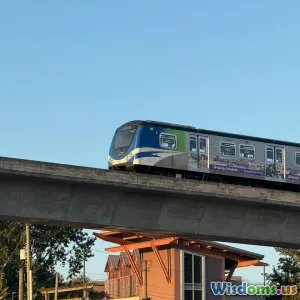
Routing Protocol Trends to Watch in the Coming Years
16 min read Explore the latest trends shaping routing protocols and how they impact modern networks in the coming years. (0 Reviews)
Routing Protocol Trends to Watch in the Coming Years
The stakes for reliable, scalable, and intelligent data routing have never been higher. As digital transformation accelerates across nearly every sector, network traffic volumes soar, edge computing proliferates, and the cybersecurity landscape evolves. Routing protocols—essential to how devices discover paths across a network—find themselves at the heart of this change. What trends will shape routing protocol evolution in the coming years? From automation and artificial intelligence to cybersecurity integration, let’s explore the developments redefining the foundations of network routing.
Automation and Self-Driving Networks

Traditionally, network engineers have manually configured and optimized routing protocols, ensuring reliable packet delivery across sometimes complex topologies. However, such manual work is becoming unsustainable. Automated routing, powered by intent-based networking (IBN) and advanced policy engines, is simplifying network operations while enhancing accuracy.
Real-World Example: Cisco DNA Center
- Intent-Based Automation: Cisco’s Digital Network Architecture (DNA) Center uses intent-based automation to manage routing policies, minimizing manual interventions and boosting agility.
- Self-Healing: Automated diagnostics and incident resolution rapidly adjust routes or reroute around network faults, leading to substantially reduced mean time to repair (MTTR).
This is echoed in Juniper Networks' Mist AI platform. Administrators set performance objectives—Mist monitors, learns, and automatically pushes changes to routing, optimizing even vast, distributed environments in seconds. As a result, common issues like misconfigurations or protocol mismatches, which historically required troubleshooting, are addressed proactively.
Actionable Tip: For organizations deploying or upgrading networks, prioritizing platforms with automation hooks and standard APIs can futureproof network reliability.
Integration of Artificial Intelligence and Machine Learning

Artificial Intelligence (AI) and Machine Learning (ML) are no longer emerging technologies in networking; they are becoming a fixture. Routing protocols are gaining AI-driven enhancements to optimize path selection and detect anomalies faster than human-centric monitoring systems could.
Key Developments
- Predictive Algorithms: AI can routinely predict traffic surges or failures by analyzing historical data, then adjust route advertisements preemptively.
- Intent-Based Routing Decisions: Instead of static algorithms, dynamic ML models recommend routes based on changing application requirements, SLAs, or emerging threats.
Example: BGP with AI Enhancements
The Border Gateway Protocol (BGP) is foundational for internet traffic. Google deploys AI-powered anomaly detection for its BGP sessions, using ML to spot suspicious patterns or traffic shifts and, if necessary, reroute data to mitigate disruptions or bypass malicious actors.
Advice: Investing in routing platforms with AI/ML integration prepares your network for scalability challenges—especially crucial as your business, cloud usage, and IoT fleet grow.
Greater Focus on Security-Conscious Routing

With cyberattacks growing more sophisticated, trust boundaries increasingly blur. Classic routing protocols—designed for connectivity, not security—are being updated to resist advanced threats, such as route hijacking and man-in-the-middle attacks.
Examples of Next-Gen Secure Routing
- BGP Route Filtering and RPKI: Robust BGP route validation via Resource Public Key Infrastructure (RPKI) helps block propagation of malicious or erroneous routes. Facebook (Meta), for instance, employs RPKI to authenticate network route advertisements to protect against BGP hijacks.
- SD-WAN Encrypted Tunnels: SD-WAN platforms increasingly default to end-to-end encrypted, authenticated overlay routing between branches and the cloud edge, dramatically strengthening the overall security baseline.
Industry Insight: Zero Trust Networking
Multi-factor authentication for routers, cryptographically signed policies, and tight access controls are becoming standard in large enterprises, especially in critical sectors such as healthcare and finance.
Comparison Point: While security overlays on top of existing protocols (like IPsec with OSPF) work, increasingly, enterprises are gravitating toward platforms purpose-built for security, such as Secure Access Service Edge (SASE) solutions, which combine secure routing, identity, and policy management into a unified framework.
The Rise of Segment Routing

Segment Routing (SR), particularly with IPv6 (SRv6), is at the frontier of routing innovation. Rather than relying on complex, stateful MPLS (Multiprotocol Label Switching) infrastructures, segment routing codes instructions and service policies directly into packet headers.
Why Segment Routing?
- Simplicity: By encoding policy and service chains into IPv6 header fields, network complexity and the amount of routing state that routers must maintain are dramatically reduced.
- Agility: Dynamic, application-aware routing enables a single set of routers to carry traffic for multiple tenants and services, each benefiting from tailored QoS.
Deployment Example
Orange, a global telecommunications operator, has rolled out segment routing in their backbone networks, streamlining service delivery and minimizing provisioning overhead. They have reported up to 50% operational cost savings compared to their previous MPLS model, thanks in large part to simpler service chaining and failover processes powered by SR.
Tip: Operators planning large-scale network refreshes should look to SR—especially SRv6—as a means to simplify architecture, reduce latency, and futureproof connectivity.
Integration with Cloud and Multi-Cloud Environments

More businesses are distributing workloads across public, private, or hybrid clouds. Routing protocols must bridge these environments, but legacy protocols can't natively address the agility or scale required for automation- and application-aware networking.
Emerging Practices
- Cloud-Native Routing Stacks: Hyperscalers like AWS and Azure increasingly run their own optimized, distributed routing stacks (e.g., Amazon’s Transit Gateway) to ensure consistent, policy-based routing between clouds and data centers.
- Service Mesh Integration: Routing is embedded into the application layer using technologies like Istio or Linkerd, enabling traffic management, observability, and control at a service granularity inside Kubernetes clusters.
Analysis: The Latency and Policy Tradeoff
Application developers often need to balance the lowest-latency path with compliance or regulatory routing requirements (e.g., data not leaving the EU). Modern cloud-aware routing platforms support granular, policy-based path selection, not just metrics-based shortest paths.
Advice: Enterprises adopting multi-cloud should select routing solutions with programmable APIs and cloud-native compatibility—features becoming a norm among network equipment vendors.
Convergence of Routing and Network Function Virtualization (NFV)

As networks embrace software-defined paradigms, routing functions are rapidly moving away from proprietary, hardware-dependent routers to virtual network functions (VNFs) running on commodity servers.
Advantages
- Cost and Flexibility: Software-defined routing enables rapid rollouts, burst scaling, and integration with network orchestrators like OpenStack or Kubernetes.
- Rapid Innovation: Updates, enhancements, or patches can be pushed live—sometimes multiple times a week—without downtime or complex change windows.
Example in ISP Networks
AT&T’s shift from physical routers toward software-based routers running as VNFs illustrates tangible gains. AT&T now provisions capacity in under an hour (compared to weeks with physical appliances), and has unlocked new Managed WAN offerings for enterprise customers by rapidly updating virtual routing features.
Practical Insight: For organizations rolling out edge, 5G, or mobile networks, NFV-converged routing is essential to shorten service commissioning—and to rapidly adapt to new, competitive markets.
Towards Application-Aware Routing

In modern enterprise and service provider environments, not all traffic is created equal. Mission-critical video conferences, SaaS ERP traffic, or IoT control signals must get priority treatment over bulk data transfers or low-priority updates.
Application-aware routing protocols dynamically prioritize, reroute, or throttle traffic based not only on destination, but also on application identity and real-time network context.
Real-World Impressions
- Microsoft's Network: Microsoft's Azure WAN routes Microsoft Teams and critical SaaS services over prioritized paths, ensuring near-zero disruptions—key during hybrid or remote collaboration spikes.
- Service Provider Deployments: Large ISPs are introducing subscriber-level controls allowing specific SLAs per app or device, such as zero-packet loss for remote monitoring sensors.
Implementation Tips
- Deploy deep packet inspection (DPI) engines where feasible (balancing privacy with functionality).
- Select routers capable of real-time packet analytics and unambiguous application detection—a rapidly emerging capability in next-gen wired and wireless routers.
Tip: Application-centricity isn’t only for large firms; even mid-sized businesses integrating unified communications or critical SaaS can now harness advanced QoS-driven routing.
IPv6-Only Routing and the End of IPv4

IPv4 address exhaustion has been a looming problem for years, but adoption of IPv6 has been slow. This is changing as more organizations and ISPs deploy IPv6-only networks, which enable better routing scalability, security, and service uniqueness.
Facts and Figures
- As of 2024, more than 35% of internet traffic globally moves over IPv6, according to Google.
- Prominent ISPs such as Comcast and Deutsche Telekom have over 70% IPv6 penetration on their broadband networks.
- Public services—like Google, Facebook, and YouTube—offer first-class IPv6 service, ensuring modern clients take advantage of streamlined addressing and routing.
Transition Strategies
Operators increasingly employ dual-stack but are beginning to phase out IPv4 capabilities, accelerating development of routing protocols and platforms optimized for native IPv6 traffic.
Actionable Steps:
- Review all network infrastructure for IPv6 readiness. Plan test migrations.
- Prioritize IPv6 support in all new routers, firewalls, and network appliances to ‘futureproof’ investments.
Enhanced Interoperability via Open-Source and Standardization

As businesses expect seamless interconnectivity and rapidly evolving features, proprietary and monolithic routing stacks pose limitations. The open-source movement in networking—epitomized by projects like FRRouting (FRR), Quagga, and Bird—is accelerating routing innovation across devices and clouds.
Benefits of Open Routing
- Customizability: Enterprises and operators can tailor routing features to their own environments—or contribute enhancements that benefit the broader community.
- Rapid Bug Fixes: Community-driven models address security flaws or bugs much faster than some traditional vendor support models.
- Interop: Standard-based stacks more easily interoperate in multi-vendor scenarios—critical as M&A activity brings together diverse legacy architectures.
Case Example
Deutsche Telekom, one of Europe’s largest ISPs, migrated its MPLS backbone to open-source FRRouting to gain better control, accelerated upgrades, and seamless orchestration with their SDN controllers.
Professional Advice: While open-source routing is not a silver bullet for every scenario, it unlocks flexibility and often outpaces commercial stacks in feature velocity and standards compliance.
Looking Ahead: Building for Adaptability

The next era of networking will belong to organizations who treat routing—not just as a static, background capability—but as an adaptable, strategic asset. Forward-thinking organizations are:
- Embracing automation and AI to tame complexity and meet customer expectations for always-on connectivity.
- Integrating security and application-awareness as default, not bolt-on afterthoughts.
- Adopting new standards, cloud-native routing, and interoperable protocols to avoid vendor lock-in and foster innovation.
Staying abreast of these routing protocol trends ensures networks are agile and robust, no matter how demands—or threats—evolve. Ultimately, the winners will be those who invest in routing intelligence today, building networks ready to meet tomorrow’s connected world head-on.
Rate the Post
User Reviews
Popular Posts















